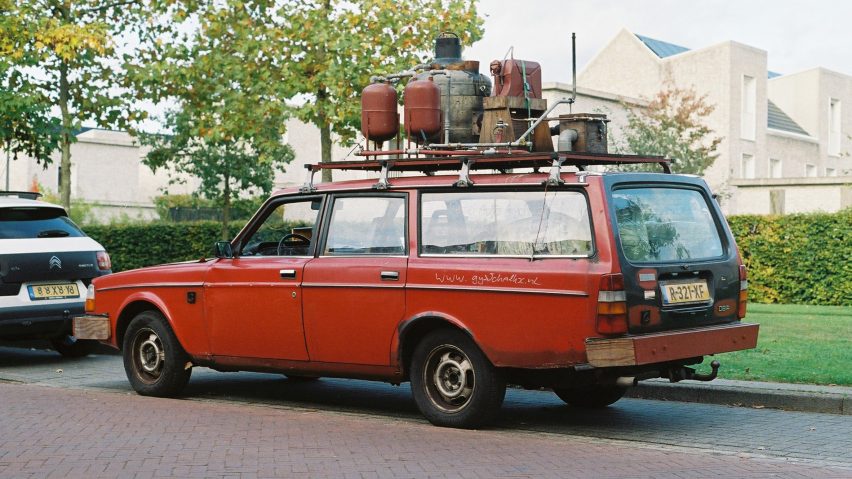Dutch designer Gijs Schalkx has retrofitted an old car to run on an unusual fuel source: waste plastic that is turned back into oil.
Schalkx's DIY project, titled The Plastic Car (Is Made of Metal), consists of an old red Volvo with a roof-mounted "de-refinery" that heats plastic to obtain oil for the fuel tank.
The project began as a follow-up to the Sloot Motor motorcycle that Schalkx made as part of his product design course at the ArtEZ University of the Arts, which runs on methane harvested from local bogs.
Schalkx, who is interested in DIY as a form of responsible design and living, wanted to build a car with a similarly original energy source and chose plastic because there was a ready supply to be found in his own household recycling.
He sourced an old car from a scrapyard in Germany, fixed it up to be road-legal and fitted his "de-refinery", which he says is quite similar to a "normal oil refinery", to the top.
Plastic is loaded into this reactor and heated in an oxygen-free environment to make it evaporate into gas. When the gas condenses again, it is in the form of oil, which then drips down through a tube into a fuel tank in the back of the car, ready for use.
Schalkx used only his own household recycling to power the car, which he drove for around half a year while making a video of the work, needing around one kilogram of plastic for every seven kilometres.
The de-refinery takes roughly one hour to produce 12 litres of oil. The designer calls the process "very inefficient", but that's part of the point.
Cars "will never be efficient" as a form of transport he says, and The Plastic Car is a way of "being honest" about that fact rather than covering it up.
"In comparison to an electric car, where you do not see the pollution because it's on the other side of the world, I tried to be very transparent, very honest," Schalkx said, referencing the outsized emissions involved in manufacturing an EV and its lithium-ion battery.
In fact, his ambition was to build a car "that looks really disgusting". As well as having the rickety-looking de-refinery strapped to its roof, the Plastic Car has an uneven paint job, wooden bumpers and Schalkx's website address scrawled on its side.
When it drives, it belches black smoke – not uncommon for an old diesel car but likely heightened by the plastic, even though the oil passes through three filters on the way to the engine.
Clear, undyed plastic produces a "nice, clear oil", Schalkx pointed out, while the oil from blue or black plastic is "really dirty".
"With old diesels, you can put whatever fuel you can find in there and they will run – so sunflower oil, used motor oil – and they did always smoke already," said Schalkx. "But if it drives on plastic, it is a bit worse."
Schalkx has had people get angry with him about his work – about the pollution, about the plastic being burnt rather than recycled. But he takes issue with current ideas about what constitutes "sustainable design", a term he sees being co-opted by companies to sell more products.
Instead, Schalkx focuses on repurposing what's already available and increasing reuse and repair by building up knowledge of how things work.
He also limited himself to using only his own household waste in the project and drove only as far as that would allow him – around 100 kilometres in a month. Compared to someone buying a new car and driving it, he says his environmental footprint was small.
"If you're a designer, you're making things, producing things, but we actually already have a surplus of things," said Schalkx. "So I don't think we can ever be really sustainable."
Another young designer who has aimed to keep old cars on the road is Australian student Alexander Burton, who invented a DIY electric car conversion kit that won a James Dyson Award.

